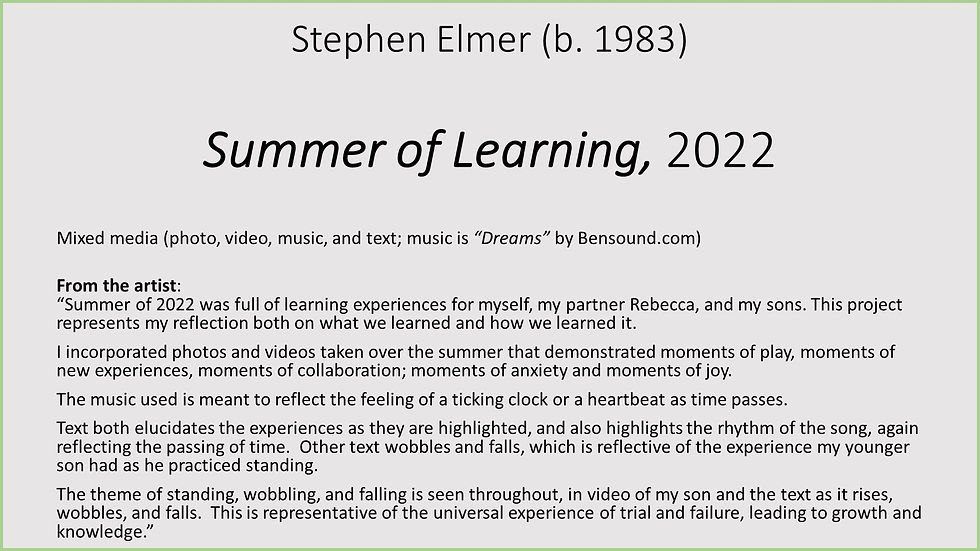Build...then RENOVATE!
- elmerst2
- Aug 8, 2022
- 3 min read
I’ve been working on an idea for an innovative learning experience - a way for students in my place of practice to engage with material in a new way.
First, a bit of context. Faculty in the medical school I work in are seeing a trend that students are becoming too concerned with “right answers,” to the detriment of application. In an effort to promote self-assessment, transfer of knowledge, and creative thinking, I designed a learning experience where students would observe clinical simulations in a virtual reality (VR) environment - and then be asked to design their own.
The use of virtual reality to acclimate students to a new experience is well-founded. It has been demonstrated that students who practice a scenario in a controlled virtual environment can complete the real-life task faster and with greater accuracy than students who received no virtual simulation experience (Maytin et al, 2015).
Of course, most medical students have no programming background or access to specialized technology - both necessary to build an actual virtual reality simulation. But with the use of a smartphone and a simple web interface, they can create a virtual “tour” of a clinical experience. Click here to take a look at my hypothetical learning experience.
My priority when building this learning experience was to create an engaging, useful, flexible learning activity for students from all walks of life. Though I did not know the terminology of UDL and intersectionality when I began the creation process, I was already aware of design considerations that could improve learning uptake and diminish risk of exclusion. For example, early on in the development of my plan I had determined to use a free web app for students to build their virtual tours with; this would provide ease of access to students by not necessitating each student to have a VR headset. (On a related note, there is evidence that immersive experiences do not require “full immersion” - i.e., virtual reality or augmented reality; learning transfer is essentially equivalent between these and computer-based simulation experiences [Moro et al, 2017]).
Of course, I did not complete this learning experience in a vacuum. I had the benefit of feedback from my peers related to how my learning experience might better align with UDL and intersectionality considerations.

For example, I originally only described superficially how students should be building their virtual tours. However, based on feedback I received, I built out a much more explicit description of the process of building a virtual environment and what tools the students had available to them - this met UDL comprehension principles by providing students “with guided information processing and visualization” (CAST, 2018).
Another example of some feedback I utilized was a suggestion related to intersectionality, making me better aware of students who might have a learning or other disability. Initially I made no accommodation for these students, but after some insight shared from my colleague, I made a point of explicitly offering accommodations for students who are differently abled.
On the other hand, I did not incorporate all of the feedback I received. For example, it was suggested that to facilitate learning assessment, I should prepare a rubric. I actually did utilize this suggestion to a certain extent in my final plan, as it further aligned my project with UDL guidelines by providing “cues and prompts to draw attention to critical features” of the project (CAST, 2018). But ultimately I saw the true assessment for understanding as being evinced by an actual summative assessment related to the students’ performance on a live simulated patient experience, which happens later in the course. My learning plan was intended to offer students an opportunity to improve their understanding of challenging content related to that upcoming assessment, not to add a second assessment.
Now that it is complete, I look forward to sharing this innovative learning experience plan with more of my colleagues, incorporating further feedback, and looking for opportunities to implement the activity in the next cohort. I am excited to see how the adjustments made in light of UDL and intersectionality might improve student engagement and understanding of course content.
References:
CAST (2018). Universal Design for Learning Guidelines version 2.2. http://udlguidelines.cast.org
Elmer, S. (2022). Screenshot of Innovative Learning Plan Version 1.0 [Image file]. CEP811 - Adapting Innovative Technologies to Education, Michigan State University.
Elmer, S. (2022, July 31). Universal Design for Learning and Intersectionality. The (Budget) IT Guy. https://elmerst2.wixsite.com/theitguy/post/universal-design-for-learning-and-intersectionality
Maytin, M., Daily, T.P., & Carillo, R.G. (2015). Virtual reality lead extraction as a method for training new physicians: a pilot study. Pacing Clin Electrophysiol 2015;38:319–25. https://doi.org/10.1111/pace.12546
Moro, C., Štromberga, Z., Raikos, A., & Stirling, A. (2017). The effectiveness of virtual and augmented reality in health sciences and medical anatomy. Anatomical Sciences Education, 10(6), 549-559. https://doi.org/10.1002/ase.1696




Comments